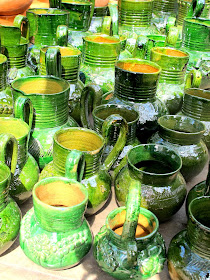The green pottery of Aztompa originated in the Oaxacan town of Santa Maria Aztompa and can be found in the markets around and in Oaxaca. This particular photo, I took in one of my favorite markets, Friday morning in Ocotlan de Morelos.
The glazed pottery is usually designed with utilitarian purposes in mind such as cooking and serving and even to hold candle and flowers.
Santa Maria Atzompa has been making pottery since the 7th to 9th century when it acted as the satellite city to its larger neighbor, Monte Alban.
It was after the Spanish conquest that the lead glazing techniques were introduced by cleric Alonso Figueroa and little has changed in the process today, green being the preferred color of choice. About 90% of the people in Santa Maria Atzompa are dedicted to making this pottery, thus contributing to the town's basic economy.
The clay is mined 4 kilometers away in an area called San Lorenzo Cacautepec. The clay is mixed with water to make it uniform. The pieces are made on a foot operated potter's wheel, then set aside to air dry for 8 days before firing. The pieces are fired twice, the glaze is applied just before the second firing.
Sunday morning over in the Abastos market in Oaxaca City.
A busy day on Wednesday at the market in Soledad Etla, you will find grandiose sized green glazed bowls filled with Atole.
Atole Dulce
and Atole Blanco.
Atole is an acquired taste for us gringos from the states. Its an ancient masa (corn) gruel made with water (sometimes milk), with or without sugar. Corn gruel was the basis of the Mesoamerican diet before 500 B.C. and Atole is just thinned corn greul.
Atole is usually made with corn kernels, cooked long enough to grind on a metate. Then more water is added and then cooked until it thickens.
You will find a variety of Atoles often combined with other ingredient in Oaxaca. Sugar is added to some. Add chile and you get Chileatole, a well known cure for a hangover. Atoles are also made with a variety of tropical fruits such as guava. Other flavoring include chocolate, vanilla, juices, nuts, seeds, rice and fresh corn.
The glazed green bowl is a perfect vessel to display Los Gusanitos de Maguey, the Maguey worms. They are dried, smoked larvae of the tiny insect that lives on the Maguey (agave) plants used to produce Mezcal.
When I am leading a tour to the Oaxacan valley, we start one day in Monte Alban followed by a stop to the Thursday market in Zaachila where we dine at La Capilla, an open-aired restaurant with long benches that serves the best Tlayuda, a signature Oaxacan antojito (snacks made of corn dough). Tlayuda
(or clayuda) is a large well-cooked tortilla spread with a black
bean paste,cheese, sliced avocados, shredded lettuce or cabbage,
tomato and decorated with a beautiful slices of radishs and then toasted on a
comal or grill.
Check out the gorgeous green glazed pitcher.
These green glazed pitchers are also perfect for making and serving hot chocolate, another favorite beverage of the area.
Comida (lunch) at one of my favorite restaurants in Oaxaca is Origen. What a gorgeous entree served in this green glazed bowl.
I bet the next time you are in Oaxaca, you can not resist buying a pitcher or bowl or both.
Last time I purchased two bowls with a pigs face with feet that I love to serve my Oaxacan peanuts or guacamole in.














No comments:
Post a Comment